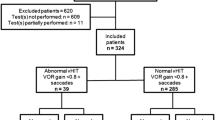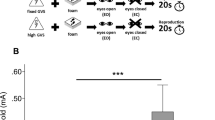Abstract
Purpose
Experimental works have indicated the potential of the vestibular system to affect body composition to be mediated by its extensive connections to brainstem nuclei involved in regulating metabolism and feeding behavior. The aim of this study was to evaluate—by means of bioelectrical impedance analysis (BIA)—the body composition in a group of chronic UVH normal-weighted patients when compared with an equally balanced group of healthy participants, serving as a control group (CG).
Methods
Forty-six chronic UVH and 60 CG participants underwent otoneurological (including video Head Impulse Test [vHIT] and static posturography testing [SPT]), BIA measurements and self-report (SRM) and performance measures (PM).
Results
Beyond significant (p < 0.001) changes in SPT variables (surface and length) and SRM/PM (including Dizziness Handicap Inventory, Dynamic Gait Index and Activity Balance Confidence scales), UVH participants demonstrated significant (p < 0.001) higher values of fat mass and visceral fat and lower values of muscle mass (p = 0.004), when compared to CG. Significant correlations were found in UVH participants between otoneurological and BIA measurements.
Conclusion
These study findings represent the first clinical in-field attempt at depicting, with the use of BIA parameters, changes in body composition related to chronic UVH. Since such alterations in metabolic parameters could be considered both the consequences and/or the cause of vestibular-related quality of life deficit, BIA parameters could be considered as cheap, easy to use, noninvasive assessments in case of chronic UVH.



Similar content being viewed by others
References
Micarelli A, Viziano A, Della-Morte D, Augimeri I, Alessandrini M (2018) Degree of functional impairment associated with vestibular hypofunction among older adults with cognitive decline. Otol Neurotol 39(5):e392–e400. https://doi.org/10.1097/mao.0000000000001746
Abe C, Kawada T, Sugimachi M (1985) Morita H (2011) Interaction between vestibulo-cardiovascular reflex and arterial baroreflex during postural change in rats. J Appl Physiol 111(6):1614–1621. https://doi.org/10.1152/japplphysiol.00501.2011
Herault S, Tobal N, Normand H, Roumy J, Denise P, Arbeille P (2002) Effect of human head flexion on the control of peripheral blood flow in microgravity and in 1 g. Eur J Appl Physiol 87(3):296–303. https://doi.org/10.1007/s00421-002-0619-z
Vignaux G, Besnard S, Denise P, Elefteriou F (2015) The vestibular system: a newly identified regulator of bone homeostasis acting through the sympathetic nervous system. Curr Osteoporos Rep 13(4):198–205. https://doi.org/10.1007/s11914-015-0271-2
Tanguy S, Quarck G, Etard O, Gauthier A, Denise P (2008) Vestibulo-ocular reflex and motion sickness in figure skaters. Eur J Appl Physiol 104(6):1031–1037. https://doi.org/10.1007/s00421-008-0859-7
McKeown J, McGeoch PD, Grieve DJ (2020) The influence of vestibular stimulation on metabolism and body composition. Diabet Med 37(1):20–28. https://doi.org/10.1111/dme.14166
Fuller PM, Jones TA, Jones SM, Fuller CA (2002) Neurovestibular modulation of circadian and homeostatic regulation: vestibulohypothalamic connection? Proc Natl Acad Sci USA 99(24):15723–15728. https://doi.org/10.1073/pnas.242251499
Bosy-Westphal A, Later W, Hitze B, Sato T, Kossel E, Gluer CC, Heller M, Muller MJ (2008) Accuracy of bioelectrical impedance consumer devices for measurement of body composition in comparison to whole body magnetic resonance imaging and dual X-ray absorptiometry. Obes Facts 1(6):319–324. https://doi.org/10.1159/000176061
Thomson R, Brinkworth GD, Buckley JD, Noakes M, Clifton PM (2007) Good agreement between bioelectrical impedance and dual-energy X-ray absorptiometry for estimating changes in body composition during weight loss in overweight young women. Clin Nutr 26(6):771–777. https://doi.org/10.1016/j.clnu.2007.08.003
Goldfield GS, Cloutier P, Mallory R, Prud’homme D, Parker T, Doucet E (2006) Validity of foot-to-foot bioelectrical impedance analysis in overweight and obese children and parents. J Sports Med Phys Fitness 46(3):447–453
Cullen KE (2012) The vestibular system: multimodal integration and encoding of self-motion for motor control. Trends Neurosci 35(3):185–196. https://doi.org/10.1016/j.tins.2011.12.001
Bigelow RT, Agrawal Y (2015) Vestibular involvement in cognition: Visuospatial ability, attention, executive function, and memory. J Vestib Res 25(2):73–89. https://doi.org/10.3233/ves-150544
Hall CD, Herdman SJ, Whitney SL, Cass SP, Clendaniel RA, Fife TD, Furman JM, Getchius TS, Goebel JA, Shepard NT, Woodhouse SN (2016) Vestibular rehabilitation for peripheral vestibular hypofunction: an evidence-based clinical practice guideline: from the American Physical Therapy Association Neurology Section. J Neurol Phys Ther 40(2):124–155. https://doi.org/10.1097/npt.0000000000000120
Alessandrini M, Micarelli A, Chiaravalloti A, Candidi M, Bruno E, Di Pietro B, Oberg J, Schillaci O, Pagani M (2014) Cerebellar metabolic involvement and its correlations with clinical parameters in vestibular neuritis. J Neurol 261(10):1976–1985. https://doi.org/10.1007/s00415-014-7449-x
Micarelli A, Viziano A, Bruno E, Micarelli E, Alessandrini M (2016) Vestibular impairment in multiple chemical sensitivity: component analysis findings. J Vestib Res 26(5–6):459–468. https://doi.org/10.3233/ves-160594
X I, B S, CS S (2003) Dietary recommendations in the report of a joint WHO/FAO expert consultation on diet, nutrition and the prevention of chronic diseases. WHO Technical Report Series 916,203: potential impact on consumption, production and trade of selected food products 1–52
Luna-Pech JA, Torres-Mendoza BM, Luna-Pech JA, Garcia-Cobas CY, Navarrete-Navarro S, Elizalde-Lozano AM (2014) Normocaloric diet improves asthma-related quality of life in obese pubertal adolescents. Int Arch Allergy Immunol 163(4):252–258. https://doi.org/10.1159/000360398
Blödow A, Pannasch S, Walther LE (2013) Detection of isolated covert saccades with the video head impulse test in peripheral vestibular disorders. Auris Nasus Larynx 40(4):348–351. https://doi.org/10.1016/j.anl.2012.11.002
Alessandrini M, Lanciani R, Bruno E, Napolitano B, Di Girolamo S (2006) Posturography frequency analysis of sound-evoked body sway in normal subjects. Eur Arch Otorhinolaryngol 263(3):248–252. https://doi.org/10.1007/s00405-005-0965-7
Nola G, Mostardini C, Salvi C, Ercolani AP, Ralli G (2010) Validity of Italian adaptation of the Dizziness Handicap Inventory (DHI) and evaluation of the quality of life in patients with acute dizziness. Acta Otorhinolaryngol Ital 30(4):190
Herdman SJ, Hall CD, Maloney B, Knight S, Ebert M, Lowe J (2015) Variables associated with outcome in patients with bilateral vestibular hypofunction: preliminary study. J Vestib Res 25(3–4):185–194. https://doi.org/10.3233/ves-150556
Alahmari KA, Sparto PJ, Marchetti GF, Redfern MS, Furman JM, Whitney SL (2014) Comparison of virtual reality based therapy with customized vestibular physical therapy for the treatment of vestibular disorders. IEEE Trans Neural Syst Rehabil Eng 22(2):389–399. https://doi.org/10.1109/tnsre.2013.2294904
Compher C, Frankenfield D, Keim N, Roth-Yousey L (2006) Best practice methods to apply to measurement of resting metabolic rate in adults: a systematic review. J Am Diet Assoc 106(6):881–903. https://doi.org/10.1016/j.jada.2006.02.009
Betts JA, Smith HA, Johnson-Bonson DA, Ellis TI, Dagnall J, Hengist A, Carroll H, Thompson D, Gonzalez JT, Afman GH (2019) The energy cost of sitting versus standing naturally in man. Med Sci Sports Exerc 51(4):726–733. https://doi.org/10.1249/mss.0000000000001841
Demura S, Sato S, Kitabayashi T (2004) Percentage of total body fat as estimated by three automatic bioelectrical impedance analyzers. J Physiol Anthropol Appl Human Sci 23(3):93–99. https://doi.org/10.2114/jpa.23.93
Vasold KL, Parks AC, Phelan DML, Pontifex MB, Pivarnik JM (2019) Reliability and validity of commercially available low-cost bioelectrical impedance analysis. Int J Sport Nutr Exerc Metab 29(4):406–410. https://doi.org/10.1123/ijsnem.2018-0283
Micarelli A, Viziano A, Augimeri I, Micarelli D, Alessandrini M (2017) Three-dimensional head-mounted gaming task procedure maximizes effects of vestibular rehabilitation in unilateral vestibular hypofunction: a randomized controlled pilot trial. Int J Rehabil Res 40(4):325–332. https://doi.org/10.1097/mrr.0000000000000244
Micarelli A, Viziano A, Bruno E, Micarelli E, Augimeri I, Alessandrini M (2018) Gradient impact of cognitive decline in unilateral vestibular hypofunction after rehabilitation: preliminary findings. Eur Arch Otorhinolaryngol 275(10):2457–2465. https://doi.org/10.1007/s00405-018-5109-y
Cai YL, Ma WL, Wang JQ, Li YQ, Li M (2008) Excitatory pathways from the vestibular nuclei to the NTS and the PBN and indirect vestibulo-cardiovascular pathway from the vestibular nuclei to the RVLM relayed by the NTS. Brain Res 1240:96–104. https://doi.org/10.1016/j.brainres.2008.08.093
Etard O, Reber A, Quarck G, Normand H, Mulder P, Denise P (2004) Vestibular control on blood pressure during parabolic flights in awake rats. NeuroReport 15(15):2357–2360. https://doi.org/10.1097/00001756-200410250-00011
Horvath TL (2005) The hardship of obesity: a soft-wired hypothalamus. Nat Neurosci 8(5):561–565. https://doi.org/10.1038/nn1453
McGeoch PD (2019) Can Vestibular Stimulation be Used to Treat Obesity?: vestibular stimulation targeting the otoliths could rebalance energy homeostasis to trigger a leaner body habitus and thus treat metabolic syndrome. BioEssays 41(2):e1800197. https://doi.org/10.1002/bies.201800197
Cone RD (2005) Anatomy and regulation of the central melanocortin system. Nat Neurosci 8(5):571–578. https://doi.org/10.1038/nn1455
Fuller PM, Jones TA, Jones SM, Fuller CA (2004) Evidence for macular gravity receptor modulation of hypothalamic, limbic and autonomic nuclei. Neuroscience 129(2):461–471. https://doi.org/10.1016/j.neuroscience.2004.05.059
Shang D, Xiong J, Xiang HB, Hao Y, Liu JH (2015) Melanocortinergic circuits from medial vestibular nuclei to the kidney defined by transneuronal transport of pseudorabies virus. Int J Clin Exp Pathol 8(2):1996–2000
Jeong JK, Diano S (2014) Prolyl carboxypeptidase mRNA expression in the mouse brain. Brain Res 1542:85–92. https://doi.org/10.1016/j.brainres.2013.10.031
Wang D, He X, Zhao Z, Feng Q, Lin R, Sun Y, Ding T, Xu F, Luo M, Zhan C (2015) Whole-brain mapping of the direct inputs and axonal projections of POMC and AgRP neurons. Front Neuroanat 9:40. https://doi.org/10.3389/fnana.2015.00040
Newlands SD, Vrabec JT, Purcell IM, Stewart CM, Zimmerman BE, Perachio AA (2003) Central projections of the saccular and utricular nerves in macaques. J Comp Neurol 466(1):31–47. https://doi.org/10.1002/cne.10876
Darlington CL, Dutia MB, Smith PF (2002) The contribution of the intrinsic excitability of vestibular nucleus neurons to recovery from vestibular damage. Eur J Neurosci 15(11):1719–1727. https://doi.org/10.1046/j.1460-9568.2002.02024.x
Tighilet B, Chabbert C (2019) Adult neurogenesis promotes balance recovery after vestibular loss. Prog Neurobiol 174:28–35. https://doi.org/10.1016/j.pneurobio.2019.01.001
Teggi R, Caldirola D, Fabiano B, Recanati P, Bussi M (2009) Rehabilitation after acute vestibular disorders. J Laryngol Otol 123(4):397–402. https://doi.org/10.1017/s0022215108002983
Kawao N, Morita H, Obata K, Tatsumi K, Kaji H (2018) Role of follistatin in muscle and bone alterations induced by gravity change in mice. J Cell Physiol 233(2):1191–1201. https://doi.org/10.1002/jcp.25986
Hammam E, Macefield VG (2017) Vestibular modulation of sympathetic nerve activity to muscle and skin in humans. Front Neurol 8:334. https://doi.org/10.3389/fneur.2017.00334
Straznicky NE, Eikelis N, Nestel PJ, Dixon JB, Dawood T, Grima MT, Sari CI, Schlaich MP, Esler MD, Tilbrook AJ, Lambert GW, Lambert EA (2012) Baseline sympathetic nervous system activity predicts dietary weight loss in obese metabolic syndrome subjects. J Clin Endocrinol Metab 97(2):605–613. https://doi.org/10.1210/jc.2011-2320
Kreidieh D, Itani L, El Masri D, Tannir H, El Ghoch M (2020) Association between reduced daily steps and sarcopenic obesity in treatment-seeking adults with obesity. Front Endocrinol (Lausanne) 11:22. https://doi.org/10.3389/fendo.2020.00022
Funding
None.
Author information
Authors and Affiliations
Corresponding author
Ethics declarations
Conflict of interests
The authors declare that they have no conflict of interest.
Ethical approval
The study was approved by the “Tor Vergata” University Hospital Institutional Review Board (approval number 35/17 on April 13th, 2017) and it adhered to the principles of the Declaration of Helsinki.
Informed consent
Informed consent was obtained from all individual participants included in the study.
Additional information
Publisher's Note
Springer Nature remains neutral with regard to jurisdictional claims in published maps and institutional affiliations.
Rights and permissions
About this article
Cite this article
Micarelli, A., Viziano, A., Granito, I. et al. Changes in body composition in unilateral vestibular hypofunction: relationships between bioelectrical impedance analysis and neuro-otological parameters. Eur Arch Otorhinolaryngol 278, 2603–2611 (2021). https://doi.org/10.1007/s00405-020-06561-z
Received:
Accepted:
Published:
Issue Date:
DOI: https://doi.org/10.1007/s00405-020-06561-z




